[English] 日本語
 Yorodumi
Yorodumi- PDB-1p7q: Crystal Structure of HLA-A2 Bound to LIR-1, a Host and Viral MHC ... -
+ Open data
Open data
- Basic information
Basic information
| Entry | Database: PDB / ID: 1p7q | ||||||
|---|---|---|---|---|---|---|---|
| Title | Crystal Structure of HLA-A2 Bound to LIR-1, a Host and Viral MHC Receptor | ||||||
 Components Components |
| ||||||
 Keywords Keywords | IMMUNE SYSTEM / HLA-A2-Lir-1 Complex | ||||||
| Function / homology |  Function and homology information Function and homology informationHLA-A specific inhibitory MHC class I receptor activity / positive regulation of gamma-delta T cell activation involved in immune response / negative regulation of serotonin secretion / MHC class Ib protein complex binding / HLA-B specific inhibitory MHC class I receptor activity / immune response-inhibiting cell surface receptor signaling pathway / inhibitory MHC class I receptor activity / negative regulation of dendritic cell differentiation / Fc receptor mediated inhibitory signaling pathway / MHC class Ib receptor activity ...HLA-A specific inhibitory MHC class I receptor activity / positive regulation of gamma-delta T cell activation involved in immune response / negative regulation of serotonin secretion / MHC class Ib protein complex binding / HLA-B specific inhibitory MHC class I receptor activity / immune response-inhibiting cell surface receptor signaling pathway / inhibitory MHC class I receptor activity / negative regulation of dendritic cell differentiation / Fc receptor mediated inhibitory signaling pathway / MHC class Ib receptor activity / MHC class Ib protein binding / negative regulation of T cell mediated cytotoxicity / immune response-regulating signaling pathway / negative regulation of CD8-positive, alpha-beta T cell activation / negative regulation of transforming growth factor beta production / MHC class I receptor activity / negative regulation of alpha-beta T cell activation / negative regulation of cytokine production involved in immune response / dendritic cell differentiation / interleukin-10-mediated signaling pathway / negative regulation of osteoclast development / protein phosphatase 1 binding / negative regulation of T cell activation via T cell receptor contact with antigen bound to MHC molecule on antigen presenting cell / negative regulation of interleukin-12 production / negative regulation of endocytosis / negative regulation of dendritic cell apoptotic process / negative regulation of interferon-beta production / negative regulation of mononuclear cell proliferation / negative regulation of natural killer cell mediated cytotoxicity / T cell proliferation involved in immune response / positive regulation of memory T cell activation / T cell mediated cytotoxicity directed against tumor cell target / TAP complex binding / positive regulation of macrophage cytokine production / Golgi medial cisterna / positive regulation of CD8-positive, alpha-beta T cell activation / CD8-positive, alpha-beta T cell activation / positive regulation of CD8-positive, alpha-beta T cell proliferation / negative regulation of interleukin-10 production / CD8 receptor binding / antigen processing and presentation of exogenous peptide antigen via MHC class I / beta-2-microglobulin binding / endoplasmic reticulum exit site / negative regulation of cell cycle / negative regulation of calcium ion transport / negative regulation of type II interferon production / MHC class I protein binding / TAP binding / antigen processing and presentation of endogenous peptide antigen via MHC class I via ER pathway, TAP-dependent / protection from natural killer cell mediated cytotoxicity / negative regulation of tumor necrosis factor production / antigen processing and presentation of endogenous peptide antigen via MHC class Ib / antigen processing and presentation of endogenous peptide antigen via MHC class I via ER pathway, TAP-independent / detection of bacterium / T cell receptor binding / negative regulation of T cell proliferation / positive regulation of defense response to virus by host / SH2 domain binding / negative regulation of receptor binding / early endosome lumen / Nef mediated downregulation of MHC class I complex cell surface expression / DAP12 interactions / transferrin transport / cellular response to iron ion / Endosomal/Vacuolar pathway / HIV-1 retropepsin / Antigen Presentation: Folding, assembly and peptide loading of class I MHC / symbiont-mediated activation of host apoptosis / retroviral ribonuclease H / peptide antigen assembly with MHC class II protein complex / lumenal side of endoplasmic reticulum membrane / exoribonuclease H / cellular response to iron(III) ion / exoribonuclease H activity / MHC class II protein complex / negative regulation of forebrain neuron differentiation / antigen processing and presentation of exogenous protein antigen via MHC class Ib, TAP-dependent / ER to Golgi transport vesicle membrane / peptide antigen assembly with MHC class I protein complex / regulation of iron ion transport / regulation of erythrocyte differentiation / HFE-transferrin receptor complex / response to molecule of bacterial origin / MHC class I peptide loading complex / T cell mediated cytotoxicity / positive regulation of T cell cytokine production / antigen processing and presentation of endogenous peptide antigen via MHC class I / antigen processing and presentation of exogenous peptide antigen via MHC class II / DNA integration / positive regulation of immune response / MHC class I protein complex / positive regulation of T cell activation / peptide antigen binding / positive regulation of receptor-mediated endocytosis / negative regulation of neurogenesis / viral genome integration into host DNA / receptor internalization / cellular response to nicotine / positive regulation of T cell mediated cytotoxicity / multicellular organismal-level iron ion homeostasis Similarity search - Function | ||||||
| Biological species |  Homo sapiens (human) Homo sapiens (human) | ||||||
| Method |  X-RAY DIFFRACTION / X-RAY DIFFRACTION /  SYNCHROTRON / SYNCHROTRON /  MOLECULAR REPLACEMENT / Resolution: 3.4 Å MOLECULAR REPLACEMENT / Resolution: 3.4 Å | ||||||
 Authors Authors | Willcox, B.E. / Thomas, L.M. / Bjorkman, P.J. | ||||||
 Citation Citation |  Journal: Nat.Immunol. / Year: 2003 Journal: Nat.Immunol. / Year: 2003Title: Crystal structure of HLA-A2 bound to LIR-1, a host and viral major histocompatibility complex receptor. Authors: Willcox, B.E. / Thomas, L.M. / Bjorkman, P.J. | ||||||
| History |
|
- Structure visualization
Structure visualization
| Structure viewer | Molecule:  Molmil Molmil Jmol/JSmol Jmol/JSmol |
|---|
- Downloads & links
Downloads & links
- Download
Download
| PDBx/mmCIF format |  1p7q.cif.gz 1p7q.cif.gz | 115.5 KB | Display |  PDBx/mmCIF format PDBx/mmCIF format |
|---|---|---|---|---|
| PDB format |  pdb1p7q.ent.gz pdb1p7q.ent.gz | 90.6 KB | Display |  PDB format PDB format |
| PDBx/mmJSON format |  1p7q.json.gz 1p7q.json.gz | Tree view |  PDBx/mmJSON format PDBx/mmJSON format | |
| Others |  Other downloads Other downloads |
-Validation report
| Summary document |  1p7q_validation.pdf.gz 1p7q_validation.pdf.gz | 454.2 KB | Display |  wwPDB validaton report wwPDB validaton report |
|---|---|---|---|---|
| Full document |  1p7q_full_validation.pdf.gz 1p7q_full_validation.pdf.gz | 491.9 KB | Display | |
| Data in XML |  1p7q_validation.xml.gz 1p7q_validation.xml.gz | 26.4 KB | Display | |
| Data in CIF |  1p7q_validation.cif.gz 1p7q_validation.cif.gz | 35.3 KB | Display | |
| Arichive directory |  https://data.pdbj.org/pub/pdb/validation_reports/p7/1p7q https://data.pdbj.org/pub/pdb/validation_reports/p7/1p7q ftp://data.pdbj.org/pub/pdb/validation_reports/p7/1p7q ftp://data.pdbj.org/pub/pdb/validation_reports/p7/1p7q | HTTPS FTP |
-Related structure data
- Links
Links
- Assembly
Assembly
| Deposited unit | 
| ||||||||
|---|---|---|---|---|---|---|---|---|---|
| 1 |
| ||||||||
| Unit cell |
|
- Components
Components
| #1: Protein | Mass: 31951.316 Da / Num. of mol.: 1 / Fragment: residue 25-300 Source method: isolated from a genetically manipulated source Source: (gene. exp.)  Homo sapiens (human) / Gene: HLA-A OR HLAA / Plasmid: BJ075 / Production host: Homo sapiens (human) / Gene: HLA-A OR HLAA / Plasmid: BJ075 / Production host:  |
|---|---|
| #2: Protein | Mass: 11748.160 Da / Num. of mol.: 1 Source method: isolated from a genetically manipulated source Source: (gene. exp.)  Homo sapiens (human) / Gene: B2M / Plasmid: BJ192 / Production host: Homo sapiens (human) / Gene: B2M / Plasmid: BJ192 / Production host:  |
| #3: Protein/peptide | Mass: 993.199 Da / Num. of mol.: 1 / Fragment: residue 463-471 / Source method: obtained synthetically / References: UniProt: P12499 |
| #4: Protein | Mass: 21998.645 Da / Num. of mol.: 1 / Fragment: residue 25-221 Source method: isolated from a genetically manipulated source Source: (gene. exp.)  Homo sapiens (human) / Plasmid: pET23a / Production host: Homo sapiens (human) / Plasmid: pET23a / Production host:  |
| Has protein modification | Y |
-Experimental details
-Experiment
| Experiment | Method:  X-RAY DIFFRACTION / Number of used crystals: 1 X-RAY DIFFRACTION / Number of used crystals: 1 |
|---|
- Sample preparation
Sample preparation
| Crystal | Density Matthews: 2.65 Å3/Da / Density % sol: 53.27 % | ||||||||||||||||||||||||||||||||||||||||||||||||||||||||||||
|---|---|---|---|---|---|---|---|---|---|---|---|---|---|---|---|---|---|---|---|---|---|---|---|---|---|---|---|---|---|---|---|---|---|---|---|---|---|---|---|---|---|---|---|---|---|---|---|---|---|---|---|---|---|---|---|---|---|---|---|---|---|
| Crystal grow | Temperature: 298 K / Method: vapor diffusion, hanging drop / pH: 8.5 Details: PEG 4000, Sodium Acetate, Tris, L-Cysteine, Triton X-100, pH 8.5, VAPOR DIFFUSION, HANGING DROP, temperature 298K | ||||||||||||||||||||||||||||||||||||||||||||||||||||||||||||
| Crystal grow | *PLUS Method: vapor diffusion, hanging drop | ||||||||||||||||||||||||||||||||||||||||||||||||||||||||||||
| Components of the solutions | *PLUS
|
-Data collection
| Diffraction | Mean temperature: 100 K |
|---|---|
| Diffraction source | Source:  SYNCHROTRON / Site: SYNCHROTRON / Site:  ALS ALS  / Beamline: 5.0.3 / Wavelength: 0.992 Å / Beamline: 5.0.3 / Wavelength: 0.992 Å |
| Detector | Type: ADSC QUANTUM 4 / Detector: CCD / Date: Oct 28, 2001 |
| Radiation | Monochromator: double crystal / Protocol: SINGLE WAVELENGTH / Monochromatic (M) / Laue (L): M / Scattering type: x-ray |
| Radiation wavelength | Wavelength: 0.992 Å / Relative weight: 1 |
| Reflection | Resolution: 3.4→50 Å / Num. all: 9493 / Num. obs: 9493 / % possible obs: 99.9 % / Observed criterion σ(F): 1 / Observed criterion σ(I): 1 / Redundancy: 6 % / Rmerge(I) obs: 0.18 / Net I/σ(I): 11.7 |
| Reflection shell | Resolution: 3.4→3.61 Å / Rmerge(I) obs: 0.505 / Mean I/σ(I) obs: 3.8 / Num. unique all: 928 / % possible all: 100 |
| Reflection | *PLUS Lowest resolution: 50 Å / Num. measured all: 61195 / Rmerge(I) obs: 0.18 |
| Reflection shell | *PLUS Lowest resolution: 3.5 Å / % possible obs: 100 % / Num. unique obs: 928 |
- Processing
Processing
| Software |
| |||||||||||||||||||||||||
|---|---|---|---|---|---|---|---|---|---|---|---|---|---|---|---|---|---|---|---|---|---|---|---|---|---|---|
| Refinement | Method to determine structure:  MOLECULAR REPLACEMENT MOLECULAR REPLACEMENTStarting model: PDB entries 1G0X and 1AKJ Resolution: 3.4→33.11 Å / Rfactor Rfree error: 0.014 / Data cutoff high absF: 2117689.07 / Data cutoff high rms absF: 2117689.07 / Data cutoff low absF: 0 / Isotropic thermal model: GROUP / Cross valid method: THROUGHOUT / σ(F): 0 / Stereochemistry target values: Engh & Huber
| |||||||||||||||||||||||||
| Solvent computation | Solvent model: FLAT MODEL / Bsol: 35.846 Å2 / ksol: 0.298764 e/Å3 | |||||||||||||||||||||||||
| Displacement parameters | Biso mean: 42.2 Å2
| |||||||||||||||||||||||||
| Refine analyze |
| |||||||||||||||||||||||||
| Refinement step | Cycle: LAST / Resolution: 3.4→33.11 Å
| |||||||||||||||||||||||||
| Refine LS restraints |
| |||||||||||||||||||||||||
| LS refinement shell | Resolution: 3.4→3.61 Å / Rfactor Rfree error: 0.047 / Total num. of bins used: 6
| |||||||||||||||||||||||||
| Xplor file |
| |||||||||||||||||||||||||
| Refinement | *PLUS Highest resolution: 3.4 Å / Lowest resolution: 50 Å / Rfactor Rfree: 0.31 / Rfactor Rwork: 0.222 | |||||||||||||||||||||||||
| Solvent computation | *PLUS | |||||||||||||||||||||||||
| Displacement parameters | *PLUS | |||||||||||||||||||||||||
| Refine LS restraints | *PLUS
|
 Movie
Movie Controller
Controller


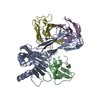
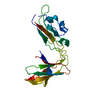
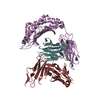
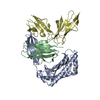
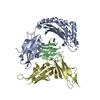
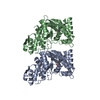
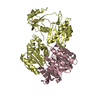
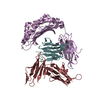
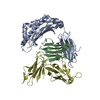
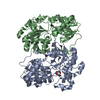
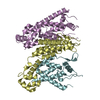

 PDBj
PDBj







